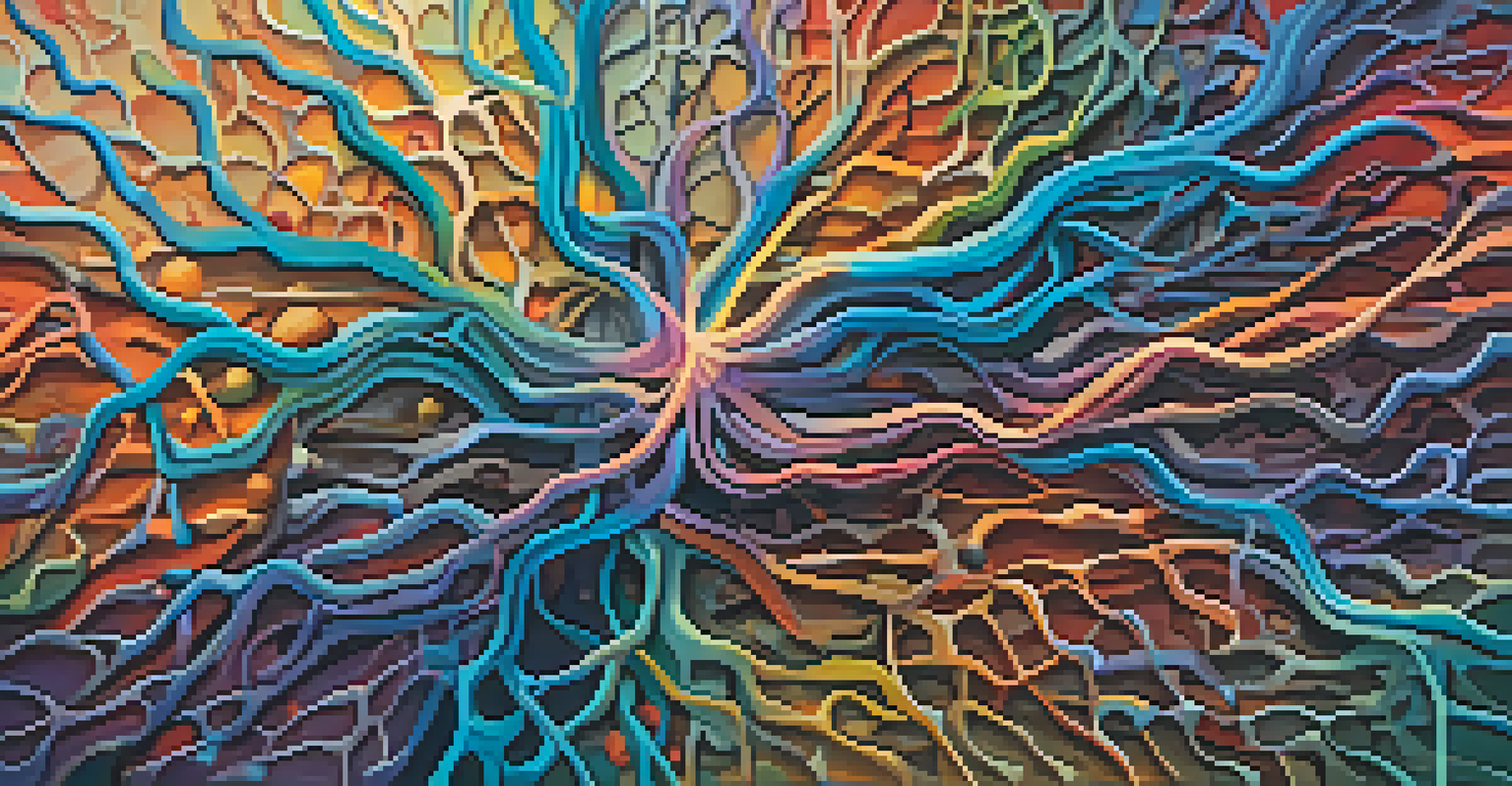Entheogens in Psychotherapy: Bridging Ancient and Modern

Understanding Entheogens and Their Historical Use
Entheogens are substances that can induce altered states of consciousness, often used in spiritual or therapeutic contexts. Historically, various cultures have utilized these substances, such as psilocybin mushrooms and ayahuasca, in rituals aimed at healing and self-discovery. The term 'entheogen' itself means 'generating the divine within,' highlighting their transformative potential. As we delve into their role in psychotherapy, it's essential to acknowledge this rich history.
The greatest discovery of my generation is that a human being can alter his life by altering his attitudes.
In ancient societies, shamans and healers employed entheogens to connect with spiritual realms, seeking guidance for their communities. These practices were deeply intertwined with cultural beliefs and traditions, often seen as sacred. By understanding these historical uses, we can appreciate how modern psychotherapy is beginning to embrace these ancient techniques in new and innovative ways.
Today, researchers are rediscovering the therapeutic potential of entheogens, sparking renewed interest in their applications within clinical settings. This intersection of ancient wisdom and modern science opens up exciting possibilities for healing, especially for those struggling with mental health issues.
The Science Behind Entheogens in Therapy
Recent studies have shown that entheogens can significantly impact the brain's neurochemistry, fostering new connections and altering perceptions. For example, psilocybin, the active compound in magic mushrooms, has been linked to increased levels of serotonin, a neurotransmitter associated with mood regulation. This biochemical change can lead to profound emotional breakthroughs during therapy sessions, helping individuals confront and process deep-seated issues.

In clinical trials, participants have reported transformative experiences that often lead to lasting changes in their mental health. These experiences can include feelings of interconnectedness, a sense of unity with nature, and a heightened understanding of oneself. Such insights can be pivotal in addressing conditions like PTSD, depression, and anxiety, where traditional therapies may fall short.
Entheogens: Ancient Healing Tools
Entheogens have a rich history of use in spiritual and therapeutic contexts across various cultures, demonstrating their transformative potential.
Moreover, the therapeutic setting plays a crucial role in these experiences. Guided sessions with trained professionals ensure safety and provide emotional support, allowing individuals to explore their minds in a structured environment. This combination of ancient practices with modern therapeutic techniques creates a powerful healing experience.
The Role of Set and Setting in Therapeutic Use
The concept of 'set and setting' is vital in understanding how entheogens work in a therapeutic context. 'Set' refers to the individual's mindset, including their expectations and mental state, while 'setting' encompasses the physical environment where the experience takes place. Both elements significantly influence the outcomes of entheogenic therapy, making it essential to create a safe and supportive atmosphere.
The mind is everything. What you think you become.
For instance, a calm, inviting space can help ease anxiety, allowing individuals to open up and engage with their experiences more fully. On the other hand, a stressful or chaotic environment can lead to negative or overwhelming experiences. This underscores the importance of careful planning and preparation in therapeutic sessions involving entheogens.
By prioritizing both set and setting, therapists can enhance the healing potential of these substances, ensuring that clients feel secure and supported throughout their journey. This mindful approach aligns with the ancient practices that emphasized the sacredness of the experience.
Challenges and Controversies in Entheogenic Therapy
Despite the promising potential of entheogens in psychotherapy, there are significant challenges and controversies surrounding their use. Legal regulations vary widely across different regions, making access to these substances difficult for both therapists and clients. Additionally, the stigma associated with drug use can deter individuals from exploring these options, even when traditional therapies have proven ineffective.
Moreover, the lack of comprehensive research and clinical guidelines raises concerns about safety and efficacy. While some individuals may have transformative experiences, others may encounter adverse effects or uncomfortable emotions. This variability highlights the need for thorough studies and well-designed therapeutic protocols to ensure the responsible use of entheogens.
Therapeutic Benefits of Entheogens
Recent studies indicate that entheogens can significantly impact mental health by fostering emotional breakthroughs and altering brain chemistry.
Ethical considerations are also paramount as the field navigates the intersection of ancient wisdom and modern medical practices. It's crucial for practitioners to respect the cultural origins of these substances and approach their use with sensitivity and awareness.
Personal Stories: Transformative Experiences with Entheogens
Many who have undergone entheogenic therapy share stories of profound transformation and healing. For instance, a veteran suffering from PTSD may describe an ayahuasca ceremony where they confronted traumatic memories in a supportive setting. This experience often leads to a newfound sense of peace and understanding, showcasing the potential of entheogens to catalyze emotional healing.
These personal narratives add a human element to the clinical data, highlighting the deeply personal nature of the healing journey. Each story is unique, reflecting individual struggles and triumphs, yet they often share common themes of connection, clarity, and acceptance. These testimonials can inspire others to consider entheogenic therapy as a viable option for their mental health challenges.
As more people come forward with their experiences, the stigma surrounding entheogens begins to dissolve, paving the way for broader acceptance and understanding. These stories serve as powerful reminders of the potential for healing that lies within both ancient practices and modern science.
Integrating Entheogens into Modern Psychotherapy Practices
The integration of entheogens into modern psychotherapy is a delicate process that requires careful consideration and respect for both scientific and spiritual dimensions. Many therapists are exploring how to incorporate these substances into their practices, often starting with small group settings or guided retreats. This approach allows clients to experience the healing benefits while ensuring a safe and supportive environment.
Collaboration among mental health professionals, researchers, and indigenous practitioners can create a comprehensive framework for entheogenic therapy. By combining traditional wisdom with contemporary therapeutic practices, we can develop more effective treatment protocols that honor the origins of these substances. Such collaborations can also help in establishing ethical guidelines and standards of care.
Set and Setting Matter in Therapy
The concepts of 'set and setting' are crucial in therapeutic contexts, as they influence the outcomes and experiences of individuals using entheogens.
As the field evolves, ongoing research and education will be crucial in shaping the future of entheogenic therapy. This includes training for therapists, public awareness campaigns, and advocating for policy changes that support access to these treatments. The journey of integrating entheogens into psychotherapy is just beginning, but the possibilities are promising.
The Future of Entheogens in Psychotherapy
Looking ahead, the future of entheogens in psychotherapy appears bright, fueled by growing interest and ongoing research. As societal attitudes shift and more studies validate their therapeutic benefits, we may see an increase in acceptance and integration of these practices within mainstream mental health care. This could revolutionize treatment options for individuals grappling with various mental health issues.
Moreover, advancements in technology, such as virtual reality and neuroimaging, may help researchers better understand the mechanisms behind entheogens' effects on the brain. These insights could further refine therapeutic approaches, making them more effective and tailored to individual needs. The marriage of ancient wisdom with cutting-edge science holds incredible promise.

Ultimately, the continued exploration of entheogens in psychotherapy represents a return to holistic healing practices that honor the mind, body, and spirit. As we bridge the gap between ancient and modern, we can unlock new pathways to healing and self-discovery, benefiting countless individuals along the way.